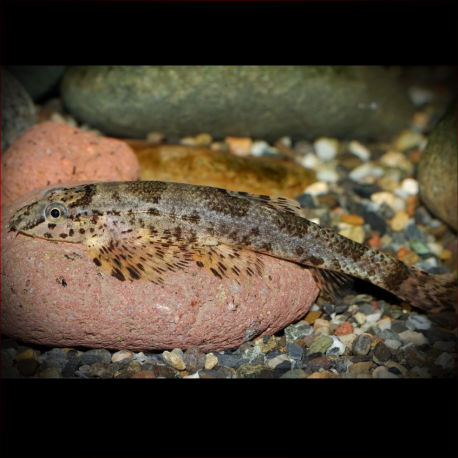More info
Datasheet
| Minimum Tank Size | 60 litres / 15.85 US gallons |
| Maximum Size | 5.0cm / 1.97inches |
| Temperature | 20°C / 68.00°F - 25°C / 77.00°F |
| Hardness | 2.02dgH / 36ppm - 12.05dgH / 215ppm |
| pH | 6.0-7.5 |
General Description
Homalopteroides weberi is a poorly known species in the aquarium hobby, with a distinct appearance characterized by 2 dark bands on the caudal-fin, 16 total pectoral-fin rays, and specific scale counts. Belonging to the family Balitoridae, these loaches are equipped with specialized morphology for life in fast-flowing waters, with flattened bodies and horizontally extended fins that allow them to cling to surfaces using a powerful sucking cup. They are often referred to as "lizard" or "gecko" loaches due to their behavior of crawling and hopping over rocks and surfaces rather than swimming in open water.
Aquarium Setup
To successfully keep Homalopteroides weberi in captivity, it is essential to replicate its natural habitat in the aquarium. The tank should have clean, well-oxygenated water with a turnover rate of 10-15 times per hour. Utilizing an oversized filter, powerheads, and airstones is recommended to maintain optimal water flow and oxygen levels. The substrate can consist of gravel, sand, or a mixture of both, complemented by water-worn rocks, pebbles, driftwood, and aquatic plants like Microsorum, Crinum, and Anubias spp. It is crucial to ensure stable water conditions in the tank and never add these loaches to a biologically immature aquarium.
Behaviour
Homalopteroides weberi is not aggressive but has specific requirements that may limit suitable tankmates. They are known to live in aggregations in nature, displaying their best behavior in groups of six or more. Keeping them in smaller groups may result in reduced boldness and interaction among individuals, making them less interesting to observe. These loaches are compatible with certain species like Barilius, Discherodontus, Garra, and various catfishes, although minor squabbles might occur with some tankmates, so research prior to selection is advised.
Feeding and Diet
Specialized micropredators, Homalopteroides weberi feed on small crustaceans, insect larvae, and other invertebrates in their natural habitat. In captivity, they may accept sinking dried foods, but their diet should primarily consist of live or frozen foods such as Daphnia, Artemia, and bloodworm to maintain good health. Balitorids are often found emaciated in pet stores, requiring a continuous supply of suitable foods to recover if purchased in a weakened state. A well-rounded diet is essential for the overall well-being of these loaches.
Reproduction & Dimorphism
Information regarding the reproduction of Homalopteroides weberi is currently unrecorded. In congeners, sexually mature females typically exhibit a slightly larger and fuller-bodied appearance compared to males, although specific sexual dimorphism for this species remains undocumented.
Habitat and Distribution
Naturally found in Sarawak state, Borneo, East Malaysia, Homalopteroides weberi is likely endemic to this region. These loaches inhabit swiftly-flowing streams and headwaters with clear, oxygen-rich water. Their preferred habitat includes areas with gravel, rocks, and boulders covered in biofilm, while aquatic plants are sporadically present. This species is specialized for life in fast-flowing waters, with adaptations that allow them to cling to surfaces using a suction-like mechanism.

